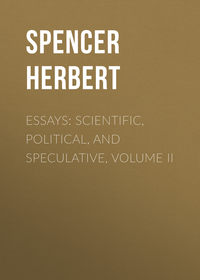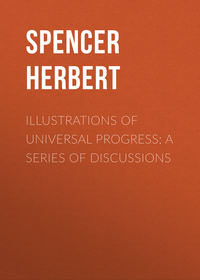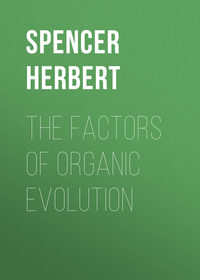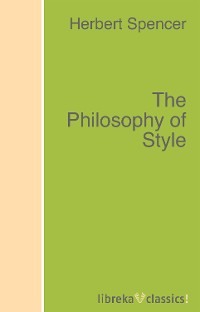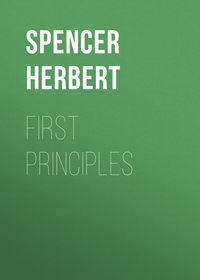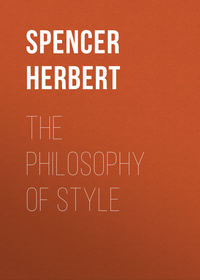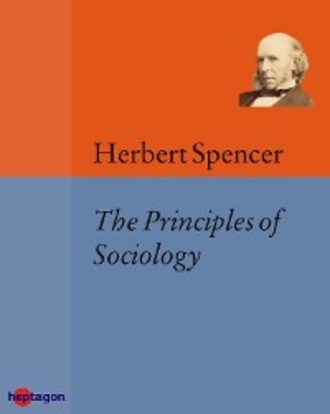
Полная версия
Principles of Sociology


Impressum.
Publisher: heptagon Verlag
Berlin 2013
ISBN: 978-3-934616-77-6
www.heptagon.de
The text was also published on the CD-ROM: «Sociological Classics, Berlin 2003.» The original book is: «Herbert Spencer: The Principles of Sociology, Greenwood 1975.»
PREFACE TO THE THIRD EDITION.
In this third edition of the Principles of Sociology, Vol. I, several improvements of importance have been made. The text has been revised; references to the works quoted and cited have been supplied; the appendices have been enlarged; and the work has now an index.
Each chapter has been carefully gone through for the purpose of removing defects of expression and with a view to condensation. By erasing superfluous words and phrases, I have reduced the text to the extent of forty pages, not-withstanding the incorporation here and there of a further illustration. This abridgment, however, has not diminished the bulk of the volume; since the additions above named occupy much more space than has been gained.
In the preface to the first edition, I explained how it happened that the reader was provided with no adequate means of verifying any of the multitudinous statements quoted; and with the explanation I joined the expression of a hope that I might eventually remove the defect. By great labour the defect has now been removed – almost though not absolutely. Some years ago I engaged a gentleman who had been with me as secretary, Mr. P. E. Smith, since deceased, to furnish references; and with the aid of the Descriptive Sociology where this availed, and where it did not by going to the works of the authors quoted, he succeeded in finding the great majority of the passages. Still, however, there remained numerous gaps. Two years since I arranged with a skilled bibliographer, Mr. Tedder, the librarian of the Athenaeum Club, to go through afresh all the quotations, and to supply the missing references while cheeking the references Mr. Smith had given. By an unwearied labour which surprised me, Mr. Tedder discovered the greater part of the passages to which references had not been supplied. The number of those which continued undiscovered was reduced by a third search, aided by clues contained in the original MS., and by information I was able to give. There now remain less than 2 per cent of unreferenced statements.
The supplying of references was not, however, the sole purpose to be achieved. Removal of inaccuracies was a further purpose. The Descriptive Sociology, from which numerous quotations were made, had passed through stages each of which gave occasion for errors. In the extracts as copied by the compilers, mistakes, literal and verbal, were certain to be not uncommon. Proper names of persons, peoples, and places, not written with due care, were likely to be in many cases mis-spelled by the printers. Thus, believing that there were many defects which, though not diminishing the values of the extracts as pieces of evidence, rendered them inexact, I desired that while the references to them were furnished, comparisons of them with the originals should be made. This task has been executed by Mr. Tedder with scrupulous care; so that his corrections have extended even to additions and omissions of commas. Concerning the results of his examination, he has written me the following letter: –
July, 1885.
DEAR MR. SPENCER,
In the second edition (1877) of the Principles of Sociology, Vol. I, placed in my hands, there were 2192 references to the 379 works quoted. In the new edition there are about 2500 references to 455 works. All of these references, with the exception of about 45, have been compared with the originals.
In the course of verification I have corrected numerous trifling errors. They were chiefly literal, and included paraphrases made by the compilers of the Descriptive Sociology which had been wrongly inserted within quotation marks. There was a small proportion of verbal errors, among which were instances of facts quoted with respect to particular tribes which the original authority had asserted generally of the whole cluster of tribes – facts, therefore, more widely true than you had alleged.
The only instances I can recall of changes affecting the value of the statements as evidence were (1) in a passage from the Iliad, originally taken from an inferior translation; (2) the deletion of the reference (on p. 298 of second edition) as to an avoidance by the Hindus of uttering the sacred name Om.
Among the 455 works quoted there are only six which are of questionable authority; but the citations from these are but few in number, and I see no reason to doubt the accuracy of the information for which they are specially responsible.
I am,
Faithfully yours,
HENRY R. TEDDER.
The statement above named as one withdrawn, was commented on by Prof. Max Müller in his Hibbert Lectures; in which he also alleged that I had erred in asserting that the Egyptians abstained from using the sacred name Osiris. This second alleged error I have dealt with in a note on page 274, where I think it is made manifest that Prof. Max Müller would have done well to examine the evidence more carefully before committing himself.
The mention of Prof. Max Müller reminds me of another matter concerning which a few words are called for. In an article on this volume in its first edition, published in the Pall Mall Gazette for February 21st, 1877, it was said that the doctrine propounded in Part I, in opposition to that of the comparative mythologists, «will shortly be taken up, as we understand, by persons specially competent in that department.» When there were at length, in 1878, announced Prof. Max Müller's Lectures on the Origin and Growth of Religion, etc., etc., I concluded that my curiosity to see a reply would at last be gratified. But on turning over the published report of his lectures, I discovered no attempt to deal with the hypothesis that religion is evolved from the ghost-theory: the sole reference to it being, as Mr. Andrew Lang remarks, some thirteen lines describing «psycholatry» as exhibited in Africa. The work proved to be a superfluous polemic against the hypothesis that fetishism is the primitive form of religion – superfluous, I say, because this hypothesis had been, I think, effectually disposed of by me in the first edition of this volume. Why Prof. Max Müller should have expended so much labour in disproving a doctrine already disproved, is not clear. Still less clear is it why, having before him the volume, and adversely criticizing certain statements in it referred to above, he entirely ignored the chapter in which was already done that which his lectures proposed to do.
What was the indirect purpose of his lectures I do not understand. He could not himself have supposed that a refutation of the fetish-theory was a refutation of the theory now standing opposed to his own; though it is not improbable that many of his hearers and readers, supposed that it was.
Concerning the new matter, little needs to be said. To Appendix A, entitled «Further Illustrations of Primitive Thought», the additions are such as practically to constitute it a second demonstration of the thesis demonstrated in Part I. To Appendix B, on «The Mythological Theory», a section has been prefixed. And Appendix C, on «The Linguistic Method of the Mythologists», is new.
Bayswater, July, 1885.
PREFACE TO VOL. I.
FOR the Science of Society, the name «Sociology» was introduced by M. Comte. Partly because it was in possession of the field, and partly because no other name sufficiently comprehensive existed, I adopted it. Though repeatedly blamed by those who condemn the word as «a barbarism», I do not regret having done so. To use, as some have suggested, the word «Politics», too narrow in its meaning as well as misleading in its connotations, would be deliberately to create confusion for the sake of avoiding a defect of no practical moment. The heterogeneity of our speech is already so great that nearly every thought is expressed in words taken from two or three languages. Already, too, it has many words formed in irregular ways from heterogeneous roots. Seeing this, I accept without much reluctance another such word: believing that the convenience and suggestiveness of our symbols are of more importance than the legitimacy of their derivation.
Probably some surprise will be felt that, containing as this work does multitudinous quotations from numerous authors, there are no references at the bottoms of pages. Some words of explanation seem needful. If foot-notes are referred to, the thread of the argument is completely broken; and even if they are not referred to, attention is disturbed by the consciousness that they are there to be looked at. Hence a loss of effect and a loss of time. As I intended to use as data for the conclusions set forth in this work, the compiled and classified facts forming the Descriptive Sociology, it occurred to me that since the arrangement of those facts is such that the author's name and the race referred to being given, the extract may in each case be found, and with it the reference, it was needless to waste space and hinder thought with these distracting foot-notes. I therefore decided to omit them. In so far as evidence furnished by the uncivilized races is concerned (which forms the greater part of the evidence contained in this volume), there exists this means of verification in nearly all cases. I found, however, that many facts from other sources had to be sought out and incorporated; and not liking to change the system I had commenced with, I left them in an unverifiable state. I recognize the defect, and hope hereafter to remedy it. In succeeding volumes I propose to adopt a method of reference which will give the reader the opportunity of consulting the authorities cited, while his attention to them will not be solicited.
The instalments of which this volume consists were issued to the subscribers at the following dates: – No. 35 (pp. 1–80) in June, 1874; No. 36 (pp. 81–160) in November, 1874; No. 37 (pp. 161–240) in February, 1875; No. 38 (pp. 241–320) in May, 1875; No. 39 (pp. 321–400) in September, 1875; No. 40 (pp. 401–462, with Appendices A & B) in December, 1875; No. 41 (pp. 465–544) in. April, 1876; No. 42 (pp. 545–624) in July, 1876; and No. 43 (pp. 625–704) in December, 1876; an extra No. (44) issued in June, 1877, completing the volume.
With this No. 44, the issue of the System of Synthetic Philosophy to subscribers, ceases: the intention being to publish the remainder of it in volumes only. The next volume will, I hope, be completed in 1880.
London, December, 1876.
I. SUPER-ORGANIC EVOLUTION.
§ 1.
OF the three broadly-distinguished kinds of Evolution outlined in First Principles, we come now to the third. The first kind, Inorganic Evolution, which, had it been dealt with, would have occupied two volumes, one dealing with Astrogeny and the other with Geogeny, was passed over because it seemed undesirable to postpone the more important applications of the doctrine for the purpose of elaborating those less important applications which logically precede them. The four volumes succeeding First Principles, have dealt with Organic Evolution: two of them with those physical phenomena presented by living aggregates, vegetal and animal, of all classes; and the other two with those more special phenomena distinguished as psychical, which the most evolved organic aggregates display. We now enter on the remaining division – Super-organic Evolution.
Although this word is descriptive, and although in First Principles, § 111, I used it with an explanatory sentence, it will be well here to exhibit its meaning more fully.
§ 2.
While we are occupied with the facts displayed by an individual organism during its growth, maturity, and decay, we are studying Organic Evolution. If we take into account, as we must, the actions and reactions going on between this organism and organisms of other kinds which its life puts it in relations with, we still do not go beyond the limits of Organic Evolution. Nor need we consider that we exceed these limits on passing to the phenomena that accompany the rearing of offspring; though here, we see the germ of a new order of phenomena. While recognizing the fact that parental co-operation foreshadows processes of a class beyond the simply organic; and while recognizing the fact that some of the products of parental co-operation, such as nests, foreshadow products of the super-organic class; we may fitly regard Super-organic Evolution as commencing only when there arises something more than the combined efforts of parents. Of course no absolute separation exists. If there has been Evolution, that form of it here distinguished as super-organic must have come by insensible steps out of the organic. But we may conveniently mark it off as including all those processes and products which imply the co-ordinated actions of many individuals.
There are various groups of super-organic phenomena, of which certain minor ones may be briefly noticed here by way of illustration.
§ 3.
Of such the most familiar, and in some respects the most instructive, are furnished by the social insects.
All know that bees and wasps form communities such that the units and the aggregates stand in very definite relations. Between the individual organization of the hive-bee and the organization of the hive as an orderly aggregate of individuals with a regularly-formed habitation, there exists a fixed connexion. Just as the germ of a wasp evolves into a complete individual; so does the adult queen-wasp, the germ of a wasp-society, evolve into a multitude of individuals with definitely-adjusted arrangements and activities. As evidence that Evolution of this order has here arisen after the same manner as the simpler orders of Evolution, it may be added that, among both bees and wasps, different genera exhibit it in different degrees. From kinds that are solitary in their habits, we pass through kinds that are social in small degrees to kinds that are social in great degrees.
Among some species of ants, Super-organic Evolution is carried much further – some species, I say; for here, also, we find that unlike stages have been reached by unlike species. The most advanced show us division of labour carried so far that different classes of individuals are structurally adapted to different functions. White ants, or termites (which, however, belong to a different order of insects), have, in addition to males and females, soldiers and workers; and there are in some cases two kinds of males and females, winged and unwinged: making six unlike forms. Of Saúba ants are found, besides the two developed sexual forms, three forms sexually undeveloped – one class of indoor workers and two classes of out-door workers. And then by some species, a further division of labour is achieved by making slaves of other ants. There is also a tending of alien insects, sometimes for the sake of their secretions, and sometimes for unknown purposes; so that, as Sir John Lubbock points out, some ants keep more domestic animals than are kept by mankind. Moreover, among members of these communities, there is a system of signalling equivalent to a rude language, and there are elaborate processes of mining, road – making, and building. In Congo, Tuckey «found a complete banza [village] of ant-hills, placed with more regularity than the, native banzas»; and Schweinfurth says a volume would be required to describe the magazines, chambers, passages, bridges, contained in a termites-mound.
But, as hinted above, though social insects exhibit a kind of evolution much higher than the merely organic – thought the aggregates they form simulate social aggregates in sundry ways; yet they are not true social aggregates. For each of them is in reality a large family. It is not a union among like individuals independent of one another in parentage, and approximately equal in their capacities; but it is a union among the offspring of one mother, carried on, in some cases for a single generation, and in some cases for more; and from this community of parentage arises the possibility of classes having unlike structures and consequent unlike functions. Instead of being allied to the specialization which arises in a society, properly so called, the specialization which arises in one of these large and complicated insect-families, is allied to that which arises between the sexes. Instead of two kinds of individuals descending from the same parents, there are several kinds of individuals descending from the same parents; and instead of a simple co-operation between two differentiated individuals in the rearing of offspring, there is an involved co-operation among sundry differentiated classes of individuals in the rearing of offspring.
§ 4.
True rudimentary forms of Super-organic Evolution are displayed only by some of the higher vertebrata.
Certain birds form communities in which there is a small amount of co-ordination. Among rooks we see such integration as is implied by the keeping-together of the same families from generation to generation, and by the exclusion of strangers. There is some vague control, some recognition of proprietorship, some punishment of offenders, and occasionally expulsion of them. A slight specialization is shown in the stationing of sentinels while the flock feeds. And usually we see an orderly action of the whole community in respect of going and coming. There has been reached a co-operation comparable to that exhibited by those small assemblages of the lowest human beings, in which there exist no governments.
Gregarious mammals of most kinds display little more than the union of mere association. In the supremacy of the strongest male in the herd, we do, indeed, see a trace of governmental organization. Some co-operation is shown, for offensive purposes, by animals that hunt in packs, and for defensive purposes by animals that are hunted; as, according to Ross, by the North American buffaloes, the bulls of which assemble to guard the cows during the calving-season against wolves and bears. Certain gregarious mammals, however, as the beavers, carry social co-operation to a considerable extent in building habitations. Finally, among sundry of the Primates, gregariousness is joined with some subordination, some combination, some display of the social sentiments. There is obedience to leaders; there is union of efforts; there are sentinels and signals; there is an idea of property; there is exchange of services; there is adoption of orphans; and the community makes efforts on behalf of endangered members.
§ 5.
These classes of truths, which might be enlarged upon to much purpose, I have here indicated for several reasons. Partly, it seemed needful to show that above organic evolution there tends to arise in various directions a further evolution. Partly, my object has been to give a comprehensive idea of this Super-organic Evolution, as not of one kind but of various kinds, determined by the characters of the various species of organisms among which it shows itself. And partly, there has been the wish to suggest that Super-organic Evolution of the highest order, arises out of an order no higher than that variously displayed in the animal world at large.
Having observed this much, we may henceforth restrict ourselves to that form of Super-organic Evolution which so immensely transcends all others in extent, in complication, in importance, as to make them relatively insignificant. I refer to the form of it which human societies exhibit in their growths, structures, functions, products. To the phenomena comprised in these, and grouped under the general title of Sociology, we now pass.
II. THE FACTORS OF SOCIAL PHENOMENA.
§ 6.
THE behaviour of a single inanimate object depends on the co-operation between its own forces and the forces to which it is exposed: instance a piece of metal, the molecules of which keep the solid state or assume the liquid state, according partly to their natures and partly to the heat-waves falling on them. Similarly with any group of inanimate objects. Be it a cart-load of bricks shot down, a barrowful of gravel turned over, or a boy's bag of marbles emptied, the behaviour of the assembled masses – here standing in a heap with steep sides, here forming one with sides much less inclined, and here spreading out and rolling in all directions – is in each case determined partly by the properties of the individual members of the group, and partly by the forces of gravitation, impact, and friction, they are subjected to.
It is equally so when the discrete aggregate consists of organic bodies, such as the members of a species. For a species increases or decreases in numbers, widens or contracts its habitat, migrates or remains stationary, continues an old mode of life or falls into a new one, under the combined influences of its intrinsic nature and the environing actions, inorganic and organic.
It is thus, too, with aggregates of men. Be it rudimentary or be it advanced, every society displays phenomena that are ascribable to the characters of its units and to the conditions under which they exist. Here, then, are the factors as primarily divided.
§ 7.
These factors are re-divisible. Within each there are groups of factors that stand in marked contrasts.
Beginning with the extrinsic factors, we see that from the outset several kinds of them are variously operative. We have climate; hot, cold, or temperate, moist or dry, constant or variable. We have surface; much or little of which is available, and the available part of which is fertile in greater or less degree; and we have configuration of surface, as uniform or multiform. Next we have the vegetal productions; here abundant in quantities and kinds, and there deficient in one or both. And besides the Flora of the region we have its Fauna, which is influential in many ways; not only by the numbers of its species and individuals, but by the proportion between those that are useful and those that are injurious. On these sets of conditions, inorganic and organic, characterizing the environment, primarily depends the possibility of social evolution.
When we turn to the intrinsic factors we have to note first, that, considered as a social unit, the individual man has physical traits, such as degrees of strength, activity, endurance, which affect the growth and structure of the society. He is in every case distinguished by emotional traits which aid, or hinder, or modify, the activities of the society, and its developments. Always, too, his degree of intelligence and the tendencies of thought peculiar to him, become co-operating causes of social quiescence or social change.
Such being the original sets of factors, we have now to note the secondary or derived sets of factors, which social evolution itself brings into play.
§ 8.
First may be set down the progressive modifications of the environment, inorganic and organic, which societies effect.
Among these are the alterations of climate caused by clearing and by drainage. Such alterations may be favourable to social growth, as where a rainy region is made less rainy by cutting down forests, or a swampy surface rendered more salubrious and fertile by carrying off water;1 or they may be unfavourable, as where, by destroying the forests, a region already dry is made arid: witness the seat of the old Semitic civilizations, and, in a less degree, Spain.




